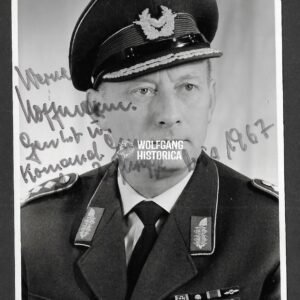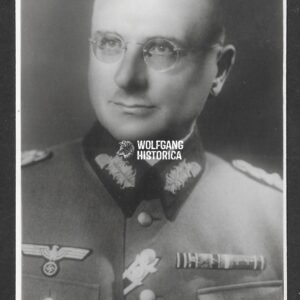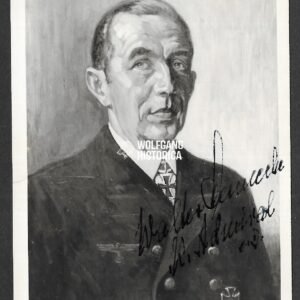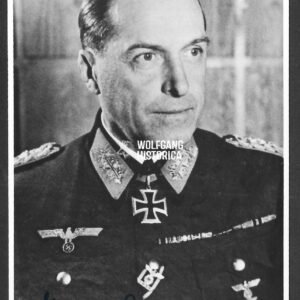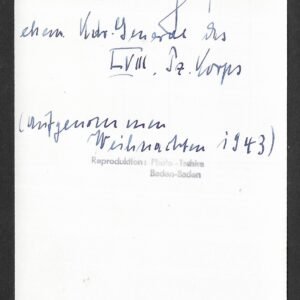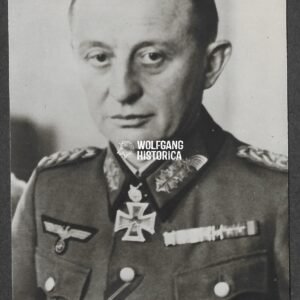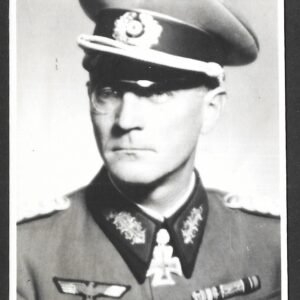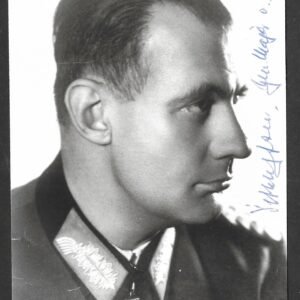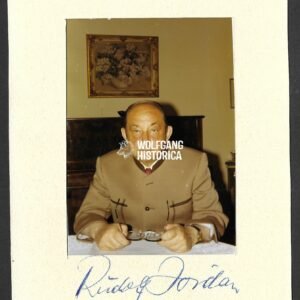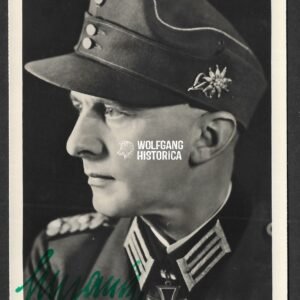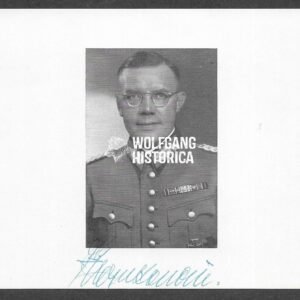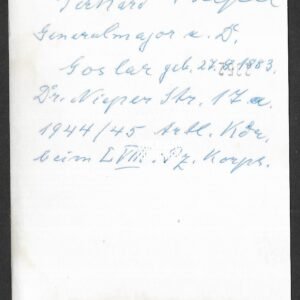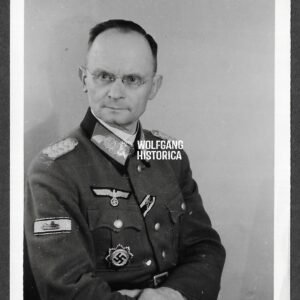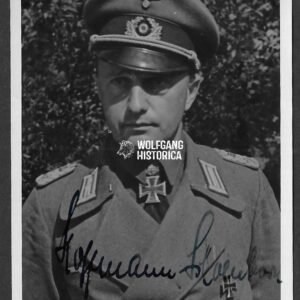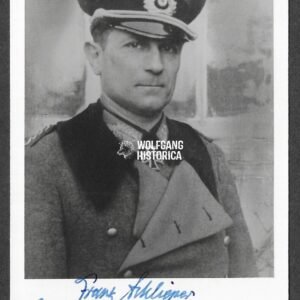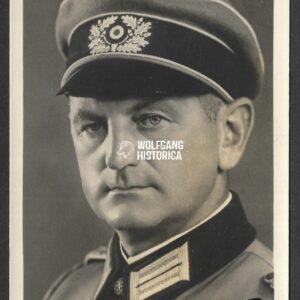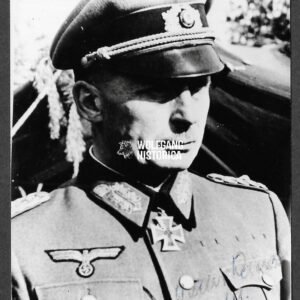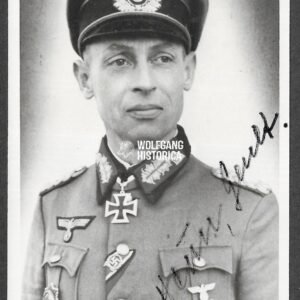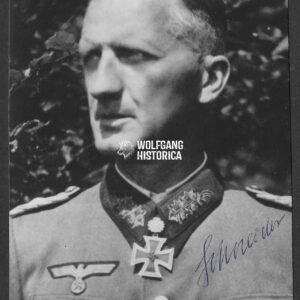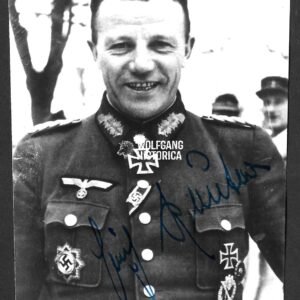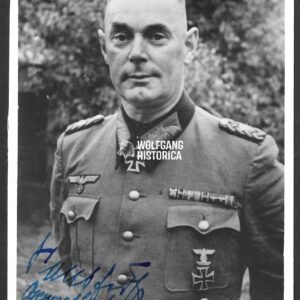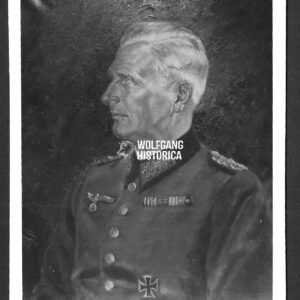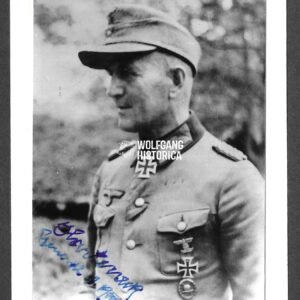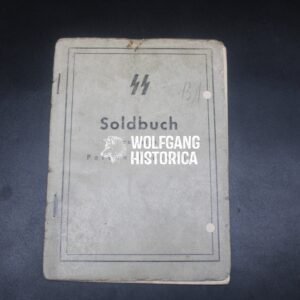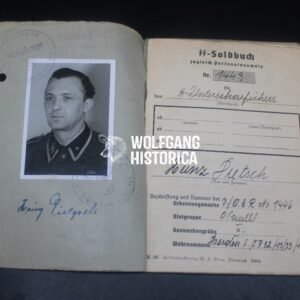Customers facing issues ordering, contact me
via info@wolfganghistorica.com or wolfganghistorica@gmail.com
NEW HOUTEN MILITARIA FAIR VIDEO ONLINE: Watch it here!
Planning a big signature update.. Stay tuned. Part 1 and 2 added.
Final Part 3 to be added soon. I can hold off with shipping until done.
Werner-Eugen Hoffmann – Kampfgruppe zbV 2 & Generalleutnant Kommandierender General der Luftwaffengruppe (BW) (DKIS)
€25,00Original Postwar Signature on a Postwar Photo of Werner-Eugen Hoffmann. Generalleutnant Werner-Eugen Hoffmann (7 November 1910, Konitz – October 1998, Münster)
Werner-Eugen Hoffmann was a distinguished Luftwaffe officer during the Second World War who continued his military career into the postwar era, rising to Generalleutnant in the Bundeswehr. His career reflects both tactical expertise and Cold War leadership within NATO frameworks.
Awards and Decorations:
-
Iron Cross 1st Class – 10 May 1940, awarded during WWII.
-
German Cross in Silver (Deutsches Kreuz in Silber) – September 1943, recognized for repeat exceptional non-combat service.
-
Grand Cross of Merit with Star, Federal Republic of Germany – 1969, honoring his postwar contributions to the Bundeswehr and NATO.
Career Highlights:
-
Joined the Luftwaffe before WWII and served throughout the conflict in various staff and operational roles.
-
After the war, entered the Bundeswehr in 1952 as an Oberst engineer, taking on planning and organizational roles within the new Air Force structure.
-
By 1961, he had risen to the rank of Generalmajor, serving as Deputy Inspector of the Air Force and Chief of Staff of the Luftwaffe leadership.
-
Later achieved Generalleutnant, becoming Deputy Commander at NATO’s BALTAP (Baltic Approaches) Headquarters—a critical position in Cold War air defense coordination.
-
Retired in the late 1960s with a distinguished legacy in both German and NATO service.
Item Details:
-
Authentic postwar signature of Generalleutnant Werner-Eugen Hoffmann.
-
Signed on a postwar photograph.
-
Condition: Clear, well-preserved autograph.
Collector’s Note:
Hoffmann's dual military legacy—as a Luftwaffe officer decorated with the German Cross in Silver, and as a prominent Bundeswehr and NATO leader honored with a Grand Cross of Merit—makes his autograph highly desirable. His role in shaping both wartime and Cold War air force structures offers collectors a rare convergence of two eras.
Hans Windeck – Infanterie-Regiment 58 & General z.b.V.
€25,00Original Postwar Signature on a Postwar Photo of Hans Windeck. Generalleutnant Hans Windeck (31 January 1888, Berlin † 19 June 1979, Herford) was a German officer whose career spanned the Imperial Army, the Reichswehr, the Schutzpolizei, and the Wehrmacht, rising to the rank of Generalleutnant during the Second World War.
Military Career Highlights:
-
Entered the Prussian Army in 1903 as a Leutnant in Infanterie-Regiment Nr. 30.
-
Served with distinction in the First World War, where he was wounded and later decorated with the Ritterkreuz des Königlichen Hausordens von Hohenzollern mit Schwertern (1918).
-
After the war, served in the Freikorps before joining the Schutzpolizei in 1920. Held key police leadership roles in Cottbus, Rheydt, Dortmund, and Brandenburg.
-
Transferred to the Wehrmacht in 1935 as an Oberstleutnant. Commanded Infanterie-Regiment 58 in Herford and later held divisional commands.
-
Promoted to Generalleutnant in March 1942.
World War II Commands:
-
Commander of Division z.b.V. 402 (1940).
-
Commander of the 152. Division (from June 1940).
-
Later appointed commander of Division z.b.V. 540 in Brünn (March 1944), serving as Wehrmachtbefehlshaber in Mähren.
-
In March 1945, became General z.b.V. in Prague, where he directed the retreat of German troops and civilians toward Pilsen at the war’s end.
Postwar Life:
-
Held in American captivity until June 1947.
-
After release, worked as a businessman and trade representative.
-
Co-founder and long-serving chairman of the Verband deutscher Soldaten (VdS) in Herford.
-
Active in local politics as a city council member for the FDP.
Item Details:
-
Authentic postwar signature of Generalleutnant Hans Windeck.
-
Signed on a postwar photograph.
-
Condition: Very good.
Collector’s Note:
Windeck represents the continuity of German officer tradition from the Kaiserreich through the Second World War, bridging service in the army, police, and later the Wehrmacht. His role in Prague during the chaotic end of the war gives his signature special historical significance.
Walter Hennecke – Seekommandant Normandie (Normandy)
€40,00Original Postwar Signature on a Postwar Photo of Walter Hennecke. Konteradmiral Walter Hennecke (23 May 1898, Betheln † 1 January 1984, Bad Lippspringe) was a German naval officer who rose to the rank of Konteradmiral during the Second World War. He is most remembered for his role as Seekommandant Normandy, where he earned the Knight’s Cross of the Iron Cross in June 1944 for his leadership during the Allied invasion of France.
Awards and Decorations:
-
Knight’s Cross of the Iron Cross (Ritterkreuz des Eisernen Kreuzes) – 26 June 1944, as Konteradmiral and Seekommandant Normandy.
Career Highlights:
-
Entered the Imperial German Navy during the First World War, beginning a career that spanned both world wars.
-
Held various command and staff positions in the Kriegsmarine, specializing in coastal defense and naval artillery.
-
As Seekommandant Normandy, he was responsible for the German coastal defenses during the Allied landings in June 1944.
-
Decorated with the Knight’s Cross in recognition of his command during these decisive battles.
-
Captured by Allied forces and held as a prisoner of war until the conflict’s end.
-
Lived quietly after the war in West Germany until his death in 1984.
Item Details:
-
Authentic postwar signature of Konteradmiral Walter Hennecke.
-
Signed on a postwar photo
-
Condition: Clear, well-preserved autograph.
Collector’s Note:
Hennecke’s signature is scarce, as he was a Knight’s Cross holder and one of the Kriegsmarine officers directly associated with the defense of Normandy during D-Day. The combination of an original postwar photo and letter makes this set particularly desirable for collectors of naval and high-command signatures.
Hannes Trautloft – Jagdgeschwader 54 “Grünherz”
€35,00Original Postwar Signature on a Postwar Photo of Hannes Trautloft. Oberst Hannes (“Hans”) Trautloft (3 March 1912, Großobringen † 12 January 1995, Bad Wiessee) was one of the Luftwaffe’s most respected fighter leaders. Commander of the famed Jagdgeschwader 54 “Grünherz”, he earned both the Knight’s Cross of the Iron Cross and the German Cross in Gold, and his wing was repeatedly cited in the official Wehrmachtbericht. Known as a principled and capable officer, Trautloft later became an Inspector of Day Fighters and postwar a Generalleutnant in the Bundesluftwaffe.
Awards and Decorations:
-
Luftwaffe Honor Goblet (Ehrenpokal für besondere Leistungen im Luftkrieg) – 8 July 1940, as Hauptmann.
-
Wehrmachtbericht Mention – 29 June 1941: JG 54 under Major Trautloft achieved its 500th aerial victory on 26 June.
-
Wehrmachtbericht Mention – 1 July 1941: At Dünaburg (Daugavpils, Latvia), Trautloft’s wing destroyed all 40 attacking Soviet aircraft.
-
Knight’s Cross of the Iron Cross (Ritterkreuz des Eisernen Kreuzes) – 27 July 1941, as Major and Kommodore of JG 54 “Grünherz”, awarded after 20 victories from over 300 sorties.
-
Wehrmachtbericht Mention – 5 April 1942: JG 54 achieved its 2000th aerial victory.
-
Wehrmachtbericht Mention – 20 June 1942: Trautloft’s wing claimed its 2000th kill on the Eastern Front.
-
German Cross in Gold (Deutsches Kreuz in Gold) – 27 July 1942, as Major and Kommodore of JG 54 “Grünherz”. (Listed as Hans in Patzwall/Scherzer.)
-
Wehrmachtbericht Mention – 21 February 1943: Under Oberstleutnant Trautloft, JG 54 achieved its 4000th aerial victory.
Career Highlights:
-
Began his combat career in the Condor Legion in Spain.
-
Appointed Kommodore of Jagdgeschwader 54 “Grünherz”, which he molded into one of the Luftwaffe’s most successful Eastern Front fighter wings.
-
Flew 560 sorties with 58 aerial victories, while under his command JG 54 achieved thousands of kills.
-
Widely admired for his competence, fairness, and concern for his men, standing out as one of the Luftwaffe’s most respected leaders.
-
Later appointed Inspector of Day Fighters (Jagdflieger-Inspekteur), overseeing Luftwaffe fighter operations.
-
Postwar, served in the Bundesluftwaffe, rising to Generalleutnant.
-
Died in 1995, leaving behind a legacy as both ace and leader.
Item Details:
-
Authentic postwar signature of Oberst Hannes Trautloft.
-
Signed on a postwar photograph.
-
Condition: Clear, well-preserved autograph.
Collector’s Note:
Trautloft’s combination of front-line success, leadership of the legendary JG 54 “Grünherz”, and repeated Wehrmachtbericht mentions makes his signed material extremely desirable. With 58 personal victories, 560 sorties, and a reputation as a fair and principled commander, his autograph bridges the appeal of both ace collectors and those focusing on Luftwaffe high command.
Walter Schwabedissen – Adjutant to Hitler, Nachtjagd & Luftwaffe in Denmark (Wartime Signed)
€135,00Original Wartime Signature on a Wartime Portrait of Walter Schwabedissen. Generalleutnant Walter Schwabedissen (16 June 1896, Iven † 19 February 1989, Gauting) was a career officer who served in both World Wars and rose to the rank of Generalleutnant in the Luftwaffe during the Second World War. Beginning his military career as an artillery officer in 1914, he transferred to the Fliegertruppe during World War I, earning the House Order of Hohenzollern with Swords for his service as an aerial observer.
Career Highlights:
-
Early Luftwaffe officer who held staff and command positions throughout the 1930s.
-
Served as Adjutant of the Luftwaffe to Adolf Hitler (1934–1935), a post of prestige and trust.
-
Commanded Kampfgruppe Merseburg, later part of Kampfgeschwader 153, before moving into senior staff roles in Luftkreis and Luftgau commands.
-
Became Chief of Staff of I. Flak-Korps at the start of WWII, later serving as Chief of Staff to the Wehrmachtbefehlshaber Niederlande.
-
Promoted to Generalmajor (1940) and Generalleutnant (1942).
-
Commanded the 2. Nachtjagd-Division (1942–43) and the 5. Jagd-Division (1943–44), overseeing Luftwaffe fighter operations in night defense and daylight air battles.
-
Appointed General der Luftwaffe in Denmark in 1944, later Kommandierender General of Luftwaffe forces in Denmark.
-
In 1945, tasked with reorganizing the Hungarian Air Force under German supervision.
-
Entered the Führerreserve in April 1945, captured by US forces in May, and released from captivity in 1947.
-
Lived in postwar Germany until his death in 1989.
Item Details:
-
Authentic wartime signature of Generalleutnant Walter Schwabedissen.
-
Signed on a wartime portrait.
-
Condition: Well-preserved with a clear period autograph.
Collector’s Note:
Schwabedissen’s long Luftwaffe career — from Adjutant to Hitler in the 1930s to divisional commands in night fighter and air defense units, and finally as Commander of Luftwaffe forces in Denmark — makes his signed portrait historically significant. An original wartime signature on a wartime portrait is far rarer than postwar examples, making this a desirable piece for Luftwaffe and high-command autograph collections.
Josef Kammhuber – 1. Nachtjagd-Division & Kammhuber Line
€50,00Original Postwar Signature on a Postwar Photo of Josef Kammhuber. General der Flieger Josef Kammhuber (19 August 1896, Minden † 25 January 1986, Bonn) was a German Luftwaffe officer who rose to the rank of General der Flieger and became the founding commander of Germany’s night fighter arm. He was decorated with the Knight’s Cross of the Iron Cross and was cited several times in the Wehrmachtbericht for the success of his units. After the war, he joined the Bundeswehr, where he became the first Inspector of the Air Force (Inspekteur der Luftwaffe), shaping West Germany’s postwar air defense.
Awards and Decorations:
-
Wehrmachtbericht Mention – 10 April 1941: Night fighter units under Kammhuber, along with flak and naval artillery, shot down 16 aircraft in one night and 7 the night before.
-
Knight’s Cross of the Iron Cross (Ritterkreuz des Eisernen Kreuzes) – 9 July 1941, as Generalmajor and Kommandeur of 1. Nachtjagd-Division.
-
Wehrmachtbericht Mention – 27 March 1942: Night fighter units under Kammhuber’s leadership celebrated their 500th aerial victory.
-
Wehrmachtbericht Mention – 31 May 1942: His night fighter units achieved their 600th aerial victory. On this night, Hauptmann Streib claimed his 25th and 26th night victories, while Oberleutnant Knacke achieved his 20th.
Career Highlights:
-
Veteran of the First World War, later returning as a professional officer in the Luftwaffe.
-
Appointed commander of the newly created 1. Nachtjagd-Division, becoming the first general of night fighters.
-
Creator of the “Kammhuber Line”, a radar-guided system of defensive night fighter sectors, pioneering integrated air defense concepts.
-
Though eventually compromised by Allied countermeasures, his system laid the groundwork for modern air defense doctrine.
-
Clashed with Erhard Milch and was removed from night fighter command in 1943, later serving as Luftwaffe commander in Scandinavia.
-
After the war, joined the Bundeswehr in 1956, reaching the rank of General der Flieger and serving as the Luftwaffe’s first Inspector.
-
Retired in 1962 and lived in Bonn until his death in 1986.
Item Details:
-
Authentic postwar signature of General der Flieger Josef Kammhuber.
-
Signed on a postwar photograph.
-
Condition: Clear, well-preserved autograph.
Collector’s Note:
As the architect of the Luftwaffe night fighter arm, a Knight’s Cross recipient, and a multiple Wehrmachtbericht honoree, Kammhuber’s signature is highly sought after. His postwar career as the Bundeswehr’s first Inspector of the Air Force gives his autograph a rare dual importance — bridging the Luftwaffe of the Second World War with NATO’s Cold War air defense.
Karl Bodenschatz – Liaison Officer between Hermann Göring & Adolf Hitler (Wounded on July 20, 1944)
€65,00Original Postwar Signature on the Reverse of an Wartime Postcard of Karl-Heinrich Bodenschatz. General der Flieger Karl-Heinrich Bodenschatz (10 December 1890, Rehau † 25 August 1979, Erlangen) was a German general and veteran of both World Wars. In the First World War he served as adjutant to the famous “Red Baron,” Manfred von Richthofen. During the Second World War, Bodenschatz became the liaison officer between Hermann Göring and Adolf Hitler, serving at the highest levels of the Third Reich’s military command.
On 20 July 1944, while serving at Hitler’s headquarters, Bodenschatz was gravely wounded in the assassination attempt at the Wolf’s Lair in Rastenburg. He received the 20. Juli 1944 Wound Badge in Gold, one of the rarest decorations of the war, awarded only to those injured in the failed plot. Bodenschatz was fortunate to survive, as officers immediately to his left and right were killed by the blast.
Item Details:
-
Authentic postwar signature of General der Flieger Karl-Heinrich Bodenschatz.
-
Signature is located on the reverse of an original wartime postcard.
-
Condition: Clear autograph on reverse; postcard well-preserved.
Collector’s Note:
As adjutant to the legendary Red Baron in WWI and later liaison between Göring and Hitler in WWII, Bodenschatz represents a unique bridge between Germany’s two great conflicts. His survival of the 20 July plot and the award of the extremely rare Gold Wound Badge (20. Juli 1944) make his signed material highly sought after. This example, signed on the reverse of an original wartime postcard, adds further desirability for serious collectors of Luftwaffe and high-command memorabilia.
Richard Schulze-Kossens – “LSSAH”, Personal Adjutant of Adolf Hitler, “Hitlerjugend” & “Nibelungen”
€185,00Original Scarce Postwar Signature on a Postwar Photo of Richard Schulze-Kossens. SS-Obersturmbannführer Richard Schulze-Kossens (2 October 1914, Schwedt/Oder † 3 July 1988, Bad Nauheim) was a senior Waffen-SS officer who rose to the rank of SS-Obersturmbannführer during the Second World War. A decorated front-line commander and staff officer, he was awarded the German Cross in Gold and served in several high-profile positions, including as Personal Adjutant to Adolf Hitler.
Awards and Decorations:
-
German Cross in Gold (Deutsches Kreuz in Gold) – 26 December 1941, as SS-Hauptsturmführer and commander of 2. Kompanie, Leibstandarte-SS “Adolf Hitler”.
Career Highlights:
-
Early member of the Leibstandarte-SS Adolf Hitler (LSSAH), where he distinguished himself in combat on the Eastern Front.
-
Decorated with the German Cross in Gold for bravery and leadership during the bitter fighting of 1941.
-
Served as Personal Adjutant to Adolf Hitler, a position of high trust and prestige within the regime’s inner circle.
-
Later returned to front-line duty, serving as regimental commander of the SS-Panzergrenadier-Regiment 25 of the 12. SS-Panzer-Division “Hitlerjugend”.
-
In 1945, appointed Kommandeur of the 38. SS-Grenadier-Division “Nibelungen”, one of the last Waffen-SS formations raised in the final months of the war.
-
Survived the conflict and imprisonment, later living in West Germany until his death in 1988.
Item Details:
-
Authentic scarce postwar signature of SS-Obersturmbannführer Richard Schulze-Kossens.
-
Signed on a postwar photograph and accompanying letter.
-
Condition: Clear, well-preserved examples of autograph material.
Collector’s Note:
Richard Schulze-Kossens’s combination of roles — as a decorated Waffen-SS combat officer, adjutant to Adolf Hitler, and commander of both elite and late-war formations — makes his signed material particularly desirable. The inclusion of both a photograph and letter with his original postwar signature makes this offering especially rare and significant for advanced collectors of Waffen-SS history and Third Reich leadership memorabilia.
Max-Josef Pemsel – 6. Gebirgs-Division
€60,00Original Postwar Signature on a Postwar Photo of Max-Josef Pemsel. Generalleutnant Max-Josef Pemsel (15 January 1897, Regensburg † 30 June 1985, Munich) was a German Army officer who rose to the rank of Generalleutnant during the Second World War. A veteran of both World Wars, he distinguished himself as commander of the 6. Gebirgs-Division in northern Finland, where he was awarded the Knight’s Cross of the Iron Cross and cited in the Wehrmachtbericht. After the war, Pemsel became a senior officer in the Bundeswehr, serving as NATO commander in Schleswig-Holstein.
Awards and Decorations:
-
Knight’s Cross of the Iron Cross (Ritterkreuz des Eisernen Kreuzes) – 9 December 1944, as Generalmajor and Kommandeur of 6. Gebirgs-Division.
Awarded for his leadership during the rearguard battles of early October 1944, when German forces retreated from northern Finland. Pemsel played a decisive role in enabling major elements of the 20. Gebirgsarmee to escape. Under his command, the Petsamo–Kirkenes road was reopened after heavy fighting, preventing a Soviet encirclement of the 6. Gebirgs-Division and frustrating a pincer attack against XIX. Gebirgs-Armeekorps. His actions earned him not only the Knight’s Cross, but also a commendation in the Wehrmachtbericht of 3 November 1944.
Career Highlights:
-
Served as an officer in World War I, later continuing his career in the Reichswehr.
-
Developed as a skilled staff officer during the interwar years.
-
Commanded the 6. Gebirgs-Division, where he distinguished himself in the demanding Arctic and Finnish theaters.
-
Later served as Chief of Staff of the 7. Armee in 1944, overseeing defenses in Normandy during the D-Day invasion.
-
Captured in 1945 and released from captivity in 1948.
-
Entered the Bundeswehr in 1956, rising to Generalleutnant and serving as NATO’s commander in Schleswig-Holstein until his retirement.
-
Lived in Munich until his death in 1985.
Item Details:
-
Authentic postwar signature of Generalleutnant Max-Josef Pemsel.
-
Signed on a postwar photograph.
-
Condition: Clear and well-preserved autograph.
Collector’s Note:
Pemsel’s recognition as commander of the 6. Gebirgs-Division in Finland — including both the Knight’s Cross and a Wehrmachtbericht mention — marks him as one of the notable late-war Gebirgsjäger leaders. His long postwar service as a Bundeswehr and NATO general adds further interest, making his autograph especially appealing to collectors of both WWII mountain troops and Cold War German leadership.
Walter Krüger – 1. Panzer-Division (Eichenlaub)
€80,00Original Postwar Signature on a Postwar Photo of Walter Krüger. General der Panzertruppe Walter Krüger (23 March 1892, Zeitz † 22 October 1973, Baden-Baden) was a highly decorated German Panzer commander who rose to the rank of General der Panzertruppe during the Second World War. Known for his leadership of the 1. Panzer-Division, he was a recipient of the Knight’s Cross of the Iron Cross with Oak Leaves, the German Cross in Gold, and several other awards for battlefield distinction.
Awards and Decorations:
-
Knight’s Cross of the Iron Cross (Ritterkreuz des Eisernen Kreuzes, 350th award) – 15 July 1941, as Generalmajor and Kommandeur of 1. Schützen-Brigade, 1. Panzer-Division (mot), XXXXI. Armeekorps, Panzergruppe 4, Heeresgruppe Nord.
Awarded for his brigade’s role in the opening weeks of Operation Barbarossa, particularly the tank battle of Rossieni–Vosiliskis (23–25 June 1941), the capture of Jakobstadt (28 June 1941), and Ostrow (4 July 1941).
-
German Cross in Gold (Deutsches Kreuz in Gold, award 170/3) – 27 August 1942, as Generalmajor and Kommandeur of 1. Panzer-Division.
-
Wehrmachtbericht Mention – 14 December 1943, as Generalleutnant and Kommandeur of 1. Panzer-Division.
The division, alongside the 68. Infanterie-Division, was officially commended for its performance in combat operations.
-
Oak Leaves to the Knight’s Cross (Ritterkreuz mit Eichenlaub, 377th award) – 24 January 1944, as Generalleutnant and Kommandeur of 1. Panzer-Division, XXXXVIII. Panzerkorps, 4. Panzer-Armee, Heeresgruppe Süd.
Awarded for distinguished leadership during the fighting around Zhitomir in late 1943, and especially for the clearing of the western bank of the Teterew River northeast of the city.
Career Highlights:
-
Veteran of the First World War, continuing his career in the Reichswehr and then the Panzerwaffe.
-
Took command of 1. Schützen-Brigade, leading from the front in the 1941 campaign in the Soviet Union.
-
Elevated to divisional command of the 1. Panzer-Division, guiding it through numerous critical operations on the Eastern Front from 1942–44.
-
Decorated with both the Knight’s Cross and Oak Leaves, recognized as one of Germany’s most capable armored division commanders.
-
Promoted to General der Panzertruppe before the end of the war.
-
Captured in 1945 and later released, living quietly in Baden-Baden until his death in 1973.
Item Details:
-
Authentic postwar signature of General der Panzertruppe Walter Krüger.
-
Signed on a postwar photograph.
-
Condition: Clear and well-preserved autograph.
Collector’s Note:
Walter Krüger’s reputation as commander of the famous 1. Panzer-Division, combined with his dual awards of the Knight’s Cross with Oak Leaves and the German Cross in Gold, make his autograph highly sought after. His leadership in some of the most significant armored battles of the Eastern Front makes this a cornerstone piece for Panzer collectors.
Wolf Hagemann – Gebirgsjäger-Regiment 139 & 336. Infanterie-Division (Narvik, Eichenlaub)
€45,00Original Postwar Signature on a Postwar Photo of Wolf Hagemann. Generalleutnant Wolf Hagemann (23 March 1898, Metz † 15 October 1983, Göttingen) was a German Army officer who rose to the rank of Generalleutnant during the Second World War. He was twice decorated for distinguished leadership in battle, earning the Knight’s Cross of the Iron Cross with Oak Leaves.
Awards and Decorations:
-
Knight’s Cross of the Iron Cross (Ritterkreuz des Eisernen Kreuzes, Nr. 211) – 4 September 1940, as Oberstleutnant and Kommandeur of III./Gebirgsjäger-Regiment 139, 3. Gebirgs-Division.
Awarded for his leadership and bravery in the Battle of Narvik (Norway, 1940), where his battalion played a decisive role in the successful mountain warfare operations against Allied forces.
-
Oak Leaves to the Knight’s Cross (Ritterkreuz mit Eichenlaub, 484th award) – 4 June 1944, as Generalmajor and Kommandeur of 336. Infanterie-Division, 17. Armee, Heeresgruppe Südukraine.
Recognized for his division’s stubborn defensive performance on the Crimean front. On 8 April 1944, his troops repulsed a major Soviet attack against the Siwasch straits. Later, during 5–12 May 1944, he successfully delayed a Soviet breakthrough until the evening of 6 May, a feat of vital importance for the survival of the 17. Armee. The Oak Leaves were personally presented to him by Adolf Hitler on 22 June 1944.
Career Highlights:
-
Served as a young officer in World War I, remaining in the Reichswehr after the war.
-
Distinguished himself early in World War II with the 3. Gebirgs-Division in Norway, where his leadership at Narvik earned him the Knight’s Cross.
-
Later promoted to divisional command, leading the 336. Infanterie-Division in the desperate defensive battles in the Crimea, earning the Oak Leaves for his leadership.
-
Promoted to Generalleutnant, continuing to command until the final phases of the war.
-
Captured in 1945 and held in captivity before returning to civilian life in West Germany. He lived until 1983.
Item Details:
-
Authentic postwar signature of Generalleutnant Wolf Hagemann.
-
Signed on a postwar photograph. Size: 7,3x10,5cm.
-
Condition: Clear and well-preserved autograph.
Collector’s Note:
Wolf Hagemann’s dual decorations — the Knight’s Cross for Narvik and the Oak Leaves for his stand in the Crimea — mark him as one of the more notable divisional commanders of the Heer. His autograph is especially desirable for collectors focusing on the Gebirgsjäger and the Eastern Front’s late-war battles.
Hans Kissel – Grenadier-Regiment 683 & Chief of Staff of the Volkssturm
€150,00Original Postwar Signature on an Wartime Photograph of Hans Kissel. Generalmajor Hans Kissel (19 February 1911, Passau † 19 November 1984, Aichach) was a German Army officer who rose to the rank of Generalmajor during the Second World War. He distinguished himself as a regimental commander on the Eastern Front, earning both the German Cross in Gold and the Knight’s Cross of the Iron Cross for his leadership in heavy fighting.
Awards and Decorations:
-
German Cross in Gold (Deutsches Kreuz in Gold) – 18 June 1942, as Oberstleutnant and Führer of III./Jäger-Regiment 228, 101. Jäger-Division, Heer.
-
Knight’s Cross of the Iron Cross (Ritterkreuz des Eisernen Kreuzes) – 17 March 1944, as Oberst and Kommandeur of Grenadier-Regiment 683, 335. Infanterie-Division, Heer.
Career Highlights:
-
Entered the Reichswehr as a young officer and advanced steadily through the interwar years.
-
Distinguished himself in 1942 as battalion commander in the 101. Jäger-Division, earning the German Cross in Gold.
-
Later commanded Grenadier-Regiment 683 of the 335. Infanterie-Division, where his skillful leadership during defensive battles on the Eastern Front brought him the Knight’s Cross in 1944.
-
Promoted to Generalmajor before the end of the war.
-
In 1945, served as Chief of Staff of the Volkssturm, directing Germany’s last-ditch defensive organization.
-
Captured by Allied forces and held in captivity before returning to civilian life in postwar Germany. He died in 1984.
Item Details:
-
Authentic postwar signature of Generalmajor Hans Kissel.
-
Signed on an original photograph (size 7.6 × 10.7 cm).
-
Condition: Clear, well-preserved autograph and photo.
Collector’s Note:
Hans Kissel’s decorations — the Knight’s Cross and German Cross in Gold — together with his unique role as Chief of Staff of the Volkssturm, make his signed photo a particularly notable item. The fact that the signature appears on an original wartime-era photograph (with dimensions 7.6 × 10.7 cm) adds further desirability for advanced collectors of Heer commanders and late-war leadership memorabilia.
Georg Graf von Rittberg – 88. Infanterie-Division (Eichenlaub)
€75,00Original Postwar Signature on a Postwar Photo of Georg Graf von Rittberg. Generalleutnant Georg Graf von Rittberg (30 May 1898, Weidenau † 6 June 1973, Wiesbaden) was a German Army officer who rose to the rank of Generalleutnant during the Second World War. A highly regarded divisional commander, he distinguished himself leading the 88. Infanterie-Division on the Eastern Front and was decorated with the Knight’s Cross of the Iron Cross with Oak Leaves. He was also twice honored in the official Wehrmachtbericht communiqués for the fighting spirit and toughness of his division.
Awards and Decorations:
-
German Cross in Gold (Deutsches Kreuz in Gold, 66/8) – 29 January 1942, as Oberstleutnant and Kommandeur of Artillerie-Regiment 131.
-
Knight’s Cross of the Iron Cross (Ritterkreuz des Eisernen Kreuzes, 2743rd award) – 21 February 1944, as Generalmajor and Kommandeur of 88. Infanterie-Division, 8. Armee, Heeresgruppe Süd.
Awarded for his role during the breakout from the Cherkassy pocket, where he commanded part of the rearguard that shielded the flanks and rear of retreating German divisions. Following heavy fighting, he led his own men out by spearheading an energetic attack along the Dshurshenzy–Potschapinzy line.
-
Oak Leaves to the Knight’s Cross (Ritterkreuz mit Eichenlaub zum Eisernen Kreuz, 624th award) – 10 October 1944, as Generalmajor and Kommandeur of 88. Infanterie-Division, XXXXII. Armeekorps, 4. Panzer-Armee, Heeresgruppe Nordukraine.
Recognized for his command of the 88. Infanterie-Division during the summer fighting of 1944, particularly in the great Vistula bend. Under his leadership, the division counterattacked south of Opatów and held defensive positions on the northern flank of the Baranów bridgehead against repeated Soviet attacks.
-
Wehrmachtbericht Mentions –
18 July 1944: Commended for toughness in combat on the northern Eastern Front.
19 August 1944: Cited for unshakeable courage and reckless determination during the defensive battles in the great bend of the Vistula.
Career Highlights:
-
Served in World War I, remaining in the Reichswehr throughout the interwar years as an artillery officer.
-
Commanded Artillerie-Regiment 131, where his leadership brought him the German Cross in Gold in 1942.
-
Promoted to command the 88. Infanterie-Division, gaining the Knight’s Cross at Cherkassy in 1944 and later the Oak Leaves during the Vistula battles.
-
Promoted to Generalleutnant, continuing to lead in the final year of the war.
-
Survived captivity and lived in Wiesbaden until his death in 1973.
Item Details:
-
Authentic postwar signature of Generalleutnant Georg Graf von Rittberg.
-
Signed on a postwar photograph.
-
Condition: Clear and well-preserved autograph.
Collector’s Note:
Georg Graf von Rittberg’s reputation as a tough divisional commander, his two Wehrmachtbericht mentions, and his award of the Knight’s Cross with Oak Leaves make his signature especially desirable. A scarce and historically significant piece for collectors of Knight’s Cross recipients and Eastern Front commanders.
Erich Dethleffsen – 330. Infanterie-Division & XXXIX. Panzerkorps
€55,00Original Postwar Signature on a Postwar Photo of Erich Dethleffsen. Generalleutnant Erich Dethleffsen (2 August 1904, Kiel † 4 July 1980, Kiel) was a German Army officer who rose to the rank of Generalleutnant during the Second World War. A career General Staff officer, he was decorated with both the German Cross in Gold and the Knight’s Cross of the Iron Cross for his service in senior staff positions on the Eastern Front. He was also the son-in-law of Generaloberst Nikolaus von Falkenhorst, the architect of the invasions of Norway and Denmark.
Awards and Decorations:
-
German Cross in Gold (Deutsches Kreuz in Gold) – 1 May 1942, as Oberstleutnant im Generalstab with 330. Infanterie-Division, Heer.
-
Knight’s Cross of the Iron Cross (Ritterkreuz des Eisernen Kreuzes) – 23 December 1943, as Oberst im Generalstab and Chef des Generalstabes of XXXIX. Panzerkorps, Heer.
Submitted on 24 November 1943; preliminary document and decoration issued on 31 December 1943 at AOK 4.
Career Highlights:
-
Entered the Reichswehr as a young officer and advanced through the interwar years into the General Staff.
-
Served with 330. Infanterie-Division, where his planning and organizational skills during Eastern Front operations earned him the German Cross in Gold in 1942.
-
Promoted to Oberst im Generalstab, serving as Chief of Staff of XXXIX. Panzerkorps, where his contributions to operational command led to the award of the Knight’s Cross in late 1943.
-
Advanced to Generalleutnant by the end of the war.
-
Captured by Allied forces in 1945 and released after captivity.
-
After the war, he published works on German military history and strategy, contributing to the Bundeswehr’s postwar intellectual framework.
-
Lived in Kiel until his death in 1980.
Item Details:
-
Authentic postwar signature of Generalleutnant Erich Dethleffsen.
-
Signed on a postwar photograph.
-
Condition: Clear and well-preserved autograph.
Helmut Kinz – Waffen-Gebirgs-Aufklärungs-Abteilung 13 “Handschar”
€75,00Original Scarce Postwar Signature on a Postwar Photo of Helmut Kinz. SS-Sturmbannführer und Major der Schutzpolizei Helmut Kinz (1 December 1915, Nagykanizsa † 19 October 1985, Klagenfurt) was a Waffen-SS and police officer who rose to the rank of SS-Sturmbannführer and Major of the Schutzpolizei during the Second World War. He is best remembered as the last commander of the Waffen-Gebirgs-Aufklärungs-Abteilung 13, the reconnaissance battalion of the 13. Waffen-Gebirgs-Division der SS “Handschar” (kroatische Nr. 1). For his leadership in the final days of the war, he was awarded the Knight’s Cross of the Iron Cross.
Award:
-
Knight’s Cross of the Iron Cross (Ritterkreuz des Eisernen Kreuzes) – 3 May 1945, as SS-Sturmbannführer and Kommandeur of Waffen-Gebirgs-Aufklärungs-Abteilung 13, 13. Waffen-Gebirgs-Division der SS “Handschar”.
Career Highlights:
-
Joined the police and later transferred to the Waffen-SS, advancing steadily through both organizations.
-
Appointed commander of the Waffen-Gebirgs-Aufklärungs-Abteilung 13, responsible for reconnaissance and mobile operations within the “Handschar” Division.
-
Led his unit during the final chaotic months of the war in the Balkans, where his command performance earned him the Knight’s Cross in May 1945—among the last decorations of its kind awarded.
-
Captured at the end of the war and later released.
-
Lived in postwar Austria until his death in 1985.
Item Details:
-
Authentic scarce postwar signature of SS-Sturmbannführer Helmut Kinz.
-
Signed on a postwar photograph.
-
Condition: Good, with a clear and well-preserved autograph.
Rudolf Jordan – Gauleiter of Halle-Merseburg & Magdeburg-Anhalt
€55,00Original Postwar Signature on a Carton (surrounding an original postwar photo) of Rudolf Jordan. Rudolf Jordan (21 June 1902, Großenlüder † 27 October 1988, Munich) was a leading NSDAP Party official who served as Gauleiter of Halle-Merseburg and Magdeburg-Anhalt during the Third Reich. As Gauleiter, he held supreme political authority in his regions and was directly responsible to Adolf Hitler.
Career Highlights:
-
Joined the NSDAP in the early years of the movement and rose quickly through the ranks.
-
Served as Gauleiter of Halle-Merseburg from 1931, later appointed Gauleiter of Magdeburg-Anhalt in 1937, positions he held throughout the war.
-
As Gauleiter, oversaw the Nazi Party’s political, administrative, and propaganda apparatus in central Germany, wielding near-total authority at the regional level.
-
Known for his loyalty to Hitler and for being one of the youngest Gauleiters in the regime.
Postwar Fate:
-
Captured by Soviet forces in 1945.
-
Sentenced to 25 years in a Soviet labor camp, where he remained imprisoned for a decade.
-
Released in October 1955, returning to West Germany.
-
Lived in Munich until his death in 1988.
Item Details:
-
Authentic postwar signature of Rudolf Jordan.
-
Signed on a postwar photograph.
-
Condition: Clear, well-preserved autograph.
Hermann Balck – 11. Panzer-Division & 4. Panzer-Armee (Brillanten)
€120,00Original Postwar Signature on a Postwar Photo of Hermann Balck. General der Panzertruppen Hermann Balck (17 December 1893, Danzig-Langfuhr † 29 November 1982, Eberbach) was one of Germany’s most outstanding Panzer commanders of the Second World War. Renowned for his tactical brilliance, he rose to the rank of General der Panzertruppen and became one of only 27 recipients of the Knight’s Cross of the Iron Cross with Oak Leaves, Swords, and Diamonds.
Awards and Decorations:
-
Knight’s Cross of the Iron Cross (Ritterkreuz des Eisernen Kreuzes) – 3 June 1940, as Oberstleutnant and Kommandeur of Schützen-Regiment 1, 1. Panzer-Division.
-
Oak Leaves to the Knight’s Cross (Eichenlaub zum Ritterkreuz des Eisernen Kreuzes) – 20 December 1942, as Generalmajor and Kommandeur of 11. Panzer-Division.
-
Swords to the Knight’s Cross with Oak Leaves (Schwerter zum Ritterkreuz mit Eichenlaub) – 4 March 1943, as Generalleutnant and Kommandeur of 11. Panzer-Division.
-
Diamonds to the Knight’s Cross with Oak Leaves and Swords (Brillanten zum Ritterkreuz mit Eichenlaub und Schwertern) – 31 August 1944, as General der Panzertruppen and Deputy Commander of 4. Panzer-Armee.
Career Highlights:
-
Distinguished himself in the 1940 French campaign, where his Schützen-Regiment spearheaded Panzer thrusts, earning him the Knight’s Cross.
-
Commanded the 11. Panzer-Division on the Eastern Front, where his bold maneuvers and rapid counterattacks earned him the Oak Leaves and Swords.
-
Promoted to General der Panzertruppen, he was entrusted with higher-level commands, including corps and army responsibilities.
-
Awarded the Diamonds in 1944, recognizing his leadership as one of the Wehrmacht’s most skilled operational commanders.
-
After the war, Balck was tried by Allied authorities and later lived quietly in West Germany until his death in 1982.
Item Details:
-
Authentic postwar signature of General der Panzertruppen Hermann Balck.
-
Signed on a postwar photograph. Postcardsize.
-
Condition: Clear and well-preserved autograph.
Friedrich August Freiherr von der Heydte – Carentan & Operation Stösser
€175,00Original Postwar Signature on a Postwar Photo of Friedrich August Freiherr von der Heydte. Oberst Friedrich August Freiherr von der Heydte (30 March 1907, München † 7 July 1994, Aham) was a German paratroop officer of the Luftwaffe during the Second World War, rising to the rank of Oberst. He earned the Knight’s Cross of the Iron Cross with Oak Leaves for his leadership of Fallschirmjäger units in some of the most famous airborne and defensive operations of the war.
Awards and Decorations:
-
Knight’s Cross of the Iron Cross (Ritterkreuz des Eisernen Kreuzes) – 21 August 1940, as Hauptmann and Kommandeur of IV./Fallschirmjäger-Regiment 1.
-
Oak Leaves to the Knight’s Cross (Eichenlaub zum Ritterkreuz des Eisernen Kreuzes) – 8 February 1945, as Oberst and Kommandeur of Fallschirmjäger-Regiment 6.
Career Highlights:
-
Entered military service before the outbreak of WWII, joining the elite Fallschirmjäger arm of the Luftwaffe.
-
Commanded IV./Fallschirmjäger-Regiment 1 during the early airborne operations of 1940, where his leadership earned him the Knight’s Cross.
-
Fought in multiple theaters including Crete, Italy, and Normandy, gaining a reputation as one of the most experienced paratroop commanders.
-
In December 1944, during the Battle of the Bulge, he led Operation Stösser, the last major German airborne operation of the war.
-
Awarded the Oak Leaves in 1945 for his leadership of Fallschirmjäger-Regiment 6 during these late-war battles.
-
After the war, became a respected law professor, politician (CSU), and author, writing extensively on military, political, and legal issues.
-
Lived until 1994, making him one of the longest-lived Oak Leaves recipients.
Item Details:
-
Authentic postwar signature of Oberst Friedrich August Freiherr von der Heydte.
-
Signed on a postwar photograph.
-
Condition: Clear and well-preserved autograph.
Collector’s Note:
Von der Heydte is among the most recognized Fallschirmjäger leaders of the Second World War. His association with Operation Stösser and his long, active postwar career as an academic and politician make his autograph especially significant. Highly desirable for collectors of elite airborne units, Knight’s Cross with Oak Leaves recipients, and Luftwaffe ground commanders.
Max-Günther Schrank – Gebirgsjäger-Regiment 100 (Wartime Signed)
€175,00Original Wartime Signature on a Postcard of Max-Günther Schrank. Generalleutnant Max-Günther Schrank (19 November 1898 † 22 September 1960) was a decorated officer of the Wehrmacht, best remembered for his service in the elite Gebirgstruppe during the Second World War. Rising through the ranks, he ultimately commanded the 5. Gebirgs-Division.
Award:
-
Knight’s Cross of the Iron Cross (Ritterkreuz des Eisernen Kreuzes) – 17 July 1941, as Oberst and Kommandeur of I./Gebirgsjäger-Regiment 100, 5. Gebirgs-Division.
Oberstleutnant Schrank has especially distinguished himself by his personal bravery and decisiveness. Through the encirclement and capture of the elusive enemy forces in the south of Crete on 1 June 1941, the operations on the island could be brought to a successful conclusion. Schrank has secured a decisive share in the total victory over the English troops.
Career Highlights:
-
A career officer who entered service during the First World War.
-
Served extensively with the 5. Gebirgs-Division, one of the Wehrmacht’s most respected mountain units.
-
Took part in campaigns across the Balkans, Crete, and the Eastern Front.
-
Later rose to the rank of Generalleutnant, commanding a full division in combat.
Item Details:
-
Authentic wartime signature of Max-Günther Schrank.
-
Signed on a postcard-sized medium.
-
Condition: Good, preserved with clear autograph.
-
Measurements: Standard postcard format.
Gordon Gollob – Jagdgeschwader 3 “Udet” & 77 “Herz As” (Brillanten)
€85,00Original Postwar Signature on a Postwar Photo of Gordon Mac Gollob. Generalmajor Gordon Mac Gollob (16 June 1912, Vienna † 7 September 1987, Sullingen) was one of the Luftwaffe’s most renowned fighter aces of the Second World War, ultimately rising to the rank of Generalmajor der Luftwaffe. Over the course of his career he achieved 150 aerial victories, becoming one of the elite recipients of the Knight’s Cross with Oak Leaves, Swords and Diamonds.
Awards and Decorations:
-
Knight’s Cross of the Iron Cross (Ritterkreuz des Eisernen Kreuzes) – 18 September 1941, as Hauptmann and Kommandeur of II./Jagdgeschwader 3 “Udet” (JG 3), after 42 confirmed aerial victories.
-
Oak Leaves to the Knight’s Cross (Eichenlaub zum Ritterkreuz) – 26 October 1941, as Hauptmann and Kommandeur of II./JG 3 “Udet”, for reaching 85 aerial victories.
-
Swords to the Knight’s Cross with Oak Leaves (Schwerter zum Ritterkreuz mit Eichenlaub) – 23 June 1942, as Hauptmann and Führer of Jagdgeschwader 77 (JG 77), for surpassing 107 aerial victories.
-
Diamonds to the Knight’s Cross with Oak Leaves and Swords (Brillanten zum Ritterkreuz mit Eichenlaub und Schwertern) – 30 August 1942, as Major and Kommodore of Jagdgeschwader 77 “Herz As”, after achieving 150 aerial victories.
-
Additionally, he received the Combined Pilot-Observer Badge with Diamonds (Gemeinsames Flugzeugführer- und Beobachterabzeichen mit Brillanten), one of the Luftwaffe’s rarest distinctions.
Career Highlights:
-
Entered the Luftwaffe before WWII and quickly rose as a skilled pilot.
-
Built his reputation as one of the Luftwaffe’s premier Experten (fighter aces) during the Eastern Front campaigns.
-
Commanded both JG 3 “Udet” and JG 77 “Herz As”, leading his Gruppen and Geschwader with distinction.
-
Later in the war, promoted to higher command responsibilities, including positions as an inspector within the fighter arm.
Johannes Fink – Kampfgeschwader 2
€35,00Original Postwar Signature on a Postwar Photo of Johannes Fink. Generalleutnant Johannes Fink (28 March 1895, Pfullingen † 1 June 1981, Pfullingen) was a highly decorated Luftwaffe officer during World War II, ultimately rising to the rank of Generalleutnant. A veteran of both World Wars, Fink began his service in the German Army during WWI and transferred to the Luftwaffe in the interwar period. He became best known for his command of bomber formations during the campaigns of 1940, and later for his leadership at divisional level.
Awards and Decorations:
-
Knight’s Cross of the Iron Cross (Ritterkreuz des Eisernen Kreuzes) – 20 June 1940, as Oberst and Geschwaderkommodore of Kampfgeschwader 2 “Holzhammer” (KG 2).
Oberst Johannes Fink distinguished himself with his Geschwader on the Western Front over the course of numerous successful sorties. He had an outstanding share in the crushing of the opposing Air Force, the breakthrough over the Maas and the subsequent covering of the southern flank of the friendly advance. Coordinated attacks by his Geschwader against enemy airports and troop assemblies met with particularly spectacular results. Oberst Fink also led his Geschwader with distinction through both difficult weather conditions and nocturnal operations. All the missions assigned to his unit were fulfilled with a minimum of losses.
-
German Cross in Gold (Deutsches Kreuz in Gold) – 1 October 1944, as Generalmajor and Kommandeur of the 2. Flieger-Division.
Career Highlights:
-
Served as a frontline officer in World War I before transitioning into aviation service in the Luftwaffe.
-
As Kommodore of KG 2, directed major bombing operations during the Western campaign of 1940, earning the Knight’s Cross.
-
Later commanded the 2. Flieger-Division, overseeing larger-scale operational deployments during the later years of the war.
Heinrich Lankenau – Generalleutnant der Ordnungspolizei and SS-Gruppenführer in “Den Haag”
€35,00Original Postwar Signature on a Postwar Paper Photo of Heinrich Lankenau. Generalleutnant der Ordnungspolizei u. SS-Gruppenführer Heinrich Bernhard Lankenau (11 October 1891, Hatten † 16 April 1983, Bad Salzuflen) was a senior German officer of the Ordnungspolizei and SS during the Second World War, holding some of the highest positions in regional police leadership. He attained the rank of Generalleutnant der Ordnungspolizei and SS-Gruppenführer.
Career Service Record:
-
15 June 1939 – Appointed Inspekteur der Ordnungspolizei Münster.
-
September 1939 – March 1940 – Befehlshaber der Ordnungspolizei im Wehrkreis VI.
-
20 April 1940 – Promoted with the Charakter als Generalmajor der Ordnungspolizei.
-
30 October 1940 – Promoted to Generalmajor der Polizei (effective 1 August 1940, seniority 6 October 1940).
-
9 November 1942 – Bestowed the Charakter als Generalleutnant der Polizei.
-
1 December 1942 (Abordnung) / 1 February 1943 (Versetzung) – Posted as Befehlshaber der Ordnungspolizei beim Höheren SS- und Polizeiführer Nord-West in Den Haag, serving until 6 January 1944.
-
20 April 1943 – Promoted to Generalleutnant der Polizei.
-
1 February 1944 – Retired from active service at his own request following conflicts with HSSPF Nord-West Hanns Albin Rauter.
-
1 July 1944 – Formally placed in retirement.
-
1 September 1944 – Temporarily tasked with administration of the Landratsamt Beckum.
Wilhelm Thomas – Infanterie-Regiment 71 (29. Infanterie-Division)
€25,00Original Postwar Signature on a Postwar Paper of Wilhelm Thomas. Generalleutnant Wilhelm Thomas (8 October 1892 † 24 August 1976) was a career officer in the German Army who rose to divisional command during the Second World War. He earned the Knight’s Cross of the Iron Cross for his leadership on the Eastern Front.
Award:
-
Knight’s Cross of the Iron Cross (Ritterkreuz des Eisernen Kreuzes) – 13 October 1941, as Oberst and Kommandeur of Infanterie-Regiment 71, 29. Infanterie-Division (mot.).
Career Highlights:
-
Served as a young officer in the First World War and continued his career in the interwar Reichswehr.
-
Distinguished himself during the invasion of the Soviet Union as commander of Infanterie-Regiment 71, part of the 29. Infanterie-Division (mot.), earning the Knight’s Cross in October 1941.
-
Later promoted to Generalleutnant, commanding multiple infantry divisions on the Eastern Front during the later stages of the war.
-
Captured in 1945 and held in Allied captivity before returning to Germany.
-
Lived in postwar Germany until his death in 1976.
Item Details:
-
Authentic postwar signature of Generalleutnant Wilhelm Thomas.
-
Signed on a postwar photograph.
-
Condition: Clear autograph, well-preserved.
Gustav Sieß – U-Boot Ace World War I (Pour le Mérite!)
€150,00Original Rare Postwar Signature on a Postwar Photograph of Gustav Sieß. Generalleutnant Gustav Sieß (11 December 1883, Hamburg † 14 October 1970, Hamburg) distinguished himself as one of Germany’s foremost U-boat aces during World War I and later served as a high-ranking officer in the Luftwaffe during World War II.
Career Highlights & Decorations:
-
As Kapitänleutnant and U‑boat commander, Sieß achieved remarkable wartime success. He sank 56 ships, totaling approximately 188,900 GRT, including the British battleship HMS Russell, the Russian battleship Peresvet, and the hospital ship Britannic, sister of the Titanic, making him one of the top submarine commanders of WWI.
-
For these exploits, he was awarded the prestigious Pour le Mérite on 24 April 1918. He had previously received both classes of the Iron Cross and the Royal House Order of Hohenzollern with Swords on 27 February 1917.
Interwar & WWII Service:
-
After the war, Sieß entered the commercial sector, founding a trading firm, Siess, von Loë & Co.
-
In 1935, at the age of 53, he returned to military service in the Luftwaffe as a Major, serving as head of logistics at the Air Ministry in Berlin. Due to illness, he retired with the rank of Generalleutnant in 1944.
-
Following the war, he was detained by Soviet authorities and sentenced to 25 years, but was released in 1955. He returned to Hamburg and lived there until his passing in 1970.
Wilhelm Meendsen-Bohlken – Befehlshaber der Deutschen Marinekommando Italiens (Admiral)
€40,00Original Postwar Signature on a Postwar Photo of Wilhelm Meendsen-Bohlken. Vizeadmiral Wilhelm Meendsen-Bohlken (5 April 1897 † 13 May 1985) was a career naval officer who served in both World Wars and rose to the rank of Vice Admiral in the Kriegsmarine. He was a recipient of the Knight’s Cross of the Iron Cross for his leadership in Italy.
Award:
-
Knight’s Cross of the Iron Cross – 11 May 1944, as Vizeadmiral and Befehlshaber der Deutschen Marinekommando Italien (Commander of German Naval Command Italy).
Career Highlights:
-
Entered the Imperial Navy as a cadet during World War I and gained early seagoing experience.
-
Continued his naval career in the interwar Reichsmarine, specializing in staff and command positions.
-
During World War II, held senior roles including Commander of German Naval Forces in Italy, directing naval operations and coordinating with Axis forces in the Mediterranean theater.
-
Promoted to Vizeadmiral, one of the Kriegsmarine’s senior flag officer ranks.
-
Survived the war and lived until 1985.
Item Details:
-
Authentic postwar signature of Vizeadmiral Wilhelm Meendsen-Bohlken.
-
Signed on a postwar photograph.
-
Condition: Well-preserved with a clear autograph.
Gerhard Triepel genannt Schulze – Artillerie-Kommandeur 485 (LXXXV. Armeekorps)
€45,00Original Postwar Signature on a Postwar Photo of Gerhard Triepel genannt Schulze. Generalmajor Gerhard Triepel genannt Schulze (12 May 1899 † 28 May 1980) was a German Army officer during the Second World War who rose to the rank of Generalmajor. He distinguished himself as an artillery commander on the Western Front in 1944, earning the German Cross in Gold.
Award:
-
German Cross in Gold (Deutsches Kreuz in Gold) – 16 October 1944, as Oberst and Kommandeur of Artillerie-Kommandeur 485, LXXXV. Armeekorps (Heer).
Career Highlights:
-
Entered military service after the First World War and remained a career officer in the interwar Reichswehr.
-
During World War II, commanded artillery formations and later senior staff positions.
-
Earned the German Cross in Gold for his leadership of Artillerie-Kommandeur 485 under the LXXXV. Armeekorps, during the bitter defensive battles of late 1944.
-
Promoted to Generalmajor, holding divisional-level responsibilities before the war’s end.
-
Survived captivity and lived in postwar Germany until his death in 1980.
Gert Gustav Paul Jeschonnek – Kriegsmarine & Inspekteur der Marine (BW) (Admiral)
€35,00Original Postwar Signature on a Postwar Photo of Gert Gustav Paul Jeschonnek. Vizeadmiral Gert Gustav Paul Jeschonnek (30 October 1912 † 18 April 1999) was a German naval officer whose career bridged both the Kriegsmarine of the Second World War and the postwar Bundesmarine of the Federal Republic of Germany. He is best remembered as Inspector of the Navy (Inspekteur der Marine), the highest-ranking officer of the postwar German Navy.
Career Highlights:
-
Entered the Kriegsmarine before World War II, serving in various naval capacities during the conflict.
-
Survived the collapse of the Third Reich and continued his career in uniform after the founding of the Bundeswehr in 1955.
-
Rose rapidly in the Bundesmarine, holding senior staff and command positions.
-
In 1967, appointed Inspector of the Navy (Inspekteur der Marine), becoming the professional head of the West German Navy and shaping its Cold War development within NATO.
-
Promoted to Vizeadmiral, one of the highest flag ranks in the Bundesmarine.
-
Retired in 1971 after a distinguished career spanning two eras of German naval history.
Item Details:
-
Authentic postwar signature of Vizeadmiral Gert Gustav Paul Jeschonnek.
-
Signed on a postwar photograph.
-
Condition: Clear autograph, well-preserved.
Wilhelm Meisel – Panzerschiff “Admiral Hipper” (Admiral)
€75,00Original Postwar Signature on a Postwar Photo of Wilhelm Meisel. Admiral Wilhelm Meisel (4 November 1891 † 7 September 1974) was a career naval officer whose service spanned both World Wars. Rising from midshipman in 1913 to Admiral in the Kriegsmarine, he commanded surface combatants in key operations and was awarded the Knight’s Cross of the Iron Cross for his leadership of the heavy cruiser Admiral Hipper.
Awards and Decorations:
-
Knight’s Cross of the Iron Cross – 26 February 1941, as Kapitän zur See and commander of the heavy cruiser “Admiral Hipper”.
-
Spanish Cross in Silver (6 June 1939).
Career Highlights:
-
Served in World War I aboard SMS Moltke, SMS Stralsund, and the commerce raider SMS Möwe.
-
Survived the scuttling of the High Seas Fleet at Scapa Flow and returned from British captivity in 1921.
-
During the interwar period, commanded a torpedo boat flotilla, held staff positions, and captained the cruiser Karlsruhe in 1929.
-
In World War II, led a destroyer flotilla during the Polish campaign (1939).
-
As commander of the heavy cruiser Admiral Hipper, directed operations in the Atlantic, for which he received the Knight’s Cross in 1941.
-
Later appointed Chief of Staff of Naval Group West (1943) and subsequently Chief of Naval Staff.
-
Promoted to Admiral, one of the senior flag officers of the Kriegsmarine.
Item Details:
-
Authentic postwar signature of Admiral Wilhelm Meisel.
-
Signed on a postwar photograph. Postcardsize.
-
Condition: Excellent preserved example, with clear autograph.
Günther Hoffmann-Schönborn – Sturmgeschütz-Abteilung 191 (Eichenlaub) (Wartime Signed)
€165,00Original Wartime Signature on a Photo of Günther Hoffmann-Schönborn. Major Günther Hoffmann-Schönborn (1 May 1905 † 4 April 1970) was a decorated assault gun commander of the Wehrmacht and one of the early notable leaders of the Sturmgeschütz units. He rose to prominence as Kommandeur of Sturmgeschütz-Abteilung 191 “Büffel”, earning both the Knight’s Cross and Oak Leaves for his battlefield leadership.
Awards and Decorations:
-
Knight’s Cross of the Iron Cross (Ritterkreuz des Eisernen Kreuzes) – 14 May 1941, as Major and Kommandeur of Sturmgeschütz-Abteilung 191 “Büffel”.
Awarded for his support of Gruppe Ens during the breakthrough of the Metaxas Line. Despite strong defensive fire and extremely difficult terrain, Hoffmann-Schönborn successfully brought his Sturmgeschütze into position to cover the attack of Gruppe Ens. This support proved invaluable, enabling the breakthrough of the enemy line and triggering the collapse of the front.
-
Oak Leaves to the Knight’s Cross (Eichenlaub zum Ritterkreuz) – 31 December 1941, as Major and Kommandeur of Sturmgeschütz-Abteilung 191 “Büffel”.
Awarded for the distinguished leadership of his Abteilung during the advance to the Dnieper River, the river crossing, and the subsequent encirclement battle of Kiev.
Career Highlights:
-
Served in the artillery branch before being transferred to the early assault gun formations.
-
As commander of Sturmgeschütz-Abteilung 191, he played a decisive role in both the Balkan campaign and on the Eastern Front.
-
His unit became well known for its aggressive use of assault guns in support of infantry and combined-arms operations.
Item Details:
-
Authentic wartime signature of Günther Hoffmann-Schönborn.
-
Size: 7.5 × 10.5 cm photograph.
-
Condition: Good, with clear autograph.
Nicolaus von Below – Adjutant of Adolf Hitler (Führerbunker ’45)
€120,00Original Postwar Signature on a Postwar Photo of Nicolaus von Below. Oberst Nicolaus von Below (20 September 1907 † 24 July 1983) was a Luftwaffe officer best remembered for his role as Adjutant to Adolf Hitler. His unique position placed him at the very heart of the Reich’s leadership throughout the Second World War, giving him a front-row perspective on critical events and decisions.
Historical Significance:
-
Served as Hitler’s Luftwaffe adjutant from 1937 until the final days of the Third Reich.
-
Present in the Führerbunker during the final battle for Berlin in April 1945.
-
On 29 April 1945, after Hitler’s marriage to Eva Braun, von Below was a witness to Hitler’s Last Will and Testament.
-
He did not sign the Political Testament but added his name to the Private Testament.
-
-
With Hitler’s permission, von Below left the bunker before the final collapse of Berlin and was later taken into Allied custody.
Postwar Life:
-
Survived captivity and later published his memoirs, providing firsthand testimony of his time as Hitler’s adjutant.
-
Lived in postwar Germany until his death in 1983.
Item Details:
-
Authentic postwar signature of Nicolaus von Below. Little bit smaller than Postcardsize.
Franz Schlieper – Grenadier-Regiment 94 & Grenadier-Regiment 1132
€65,00Original Postwar Signature on a Postwar Photo of Franz Schlieper. Generalmajor Franz Schlieper (22 August 1905 † 4 April 1974) was a career officer in the German Army during the Second World War who rose to divisional command. He was decorated with both the German Cross in Gold and the Knight’s Cross of the Iron Cross for his battlefield leadership.
Awards and Decorations:
-
German Cross in Gold (Deutsches Kreuz in Gold) – 10 January 1944, as Oberst and Kommandeur of Grenadier-Regiment 94, 32. Infanterie-Division (Heer).
-
Knight’s Cross of the Iron Cross (Ritterkreuz des Eisernen Kreuzes) – 21 September 1944, as Oberst and Kommandeur of Grenadier-Brigade 1132, Führer of the 73. Infanterie-Division (Heer).
Career Highlights:
-
Entered the Reichswehr as a young officer and advanced steadily through the interwar years.
-
Distinguished himself as regimental commander with the 32. Infanterie-Division, earning the German Cross in Gold during the heavy fighting on the Eastern Front.
-
Promoted to brigade and divisional command, he received the Knight’s Cross in late 1944 for his leadership of Grenadier-Brigade 1132 and acting command of the 73. Infanterie-Division.
-
Captured by Soviet forces in May 1945 and held in captivity until 1955.
-
Returned to Germany after release and lived there until his death in 1974.
Item Details:
-
Authentic postwar signature of Franz Schlieper.
-
Signed on a postwar photograph.
-
Condition: Excellent preserved example, with clear autograph.
Otto Hitzfeld – Infanterie-Regiment 213 & LXVII. Armeekorps (Schwertern) (Wartime Signed)
€125,00Original Wartime Signature on a Postcard of Otto Hitzfeld. General der Infanterie Otto Hitzfeld (7 May 1898 † 6 December 1990) was a highly decorated officer of the German Army during the Second World War, ultimately rising to corps command. Over the course of his career he became one of the few recipients of the Knight’s Cross of the Iron Cross with Oak Leaves and Swords, marking him among the Wehrmacht’s elite leadership.
Awards and Decorations:
-
Knight’s Cross of the Iron Cross (Ritterkreuz des Eisernen Kreuzes) – 30 October 1941, as Oberstleutnant and Kommandeur of Infanterie-Regiment 213, 73. Infanterie-Division.
-
Oak Leaves to the Knight’s Cross (Eichenlaub zum Ritterkreuz) – 17 January 1942, as Oberstleutnant and Kommandeur of Infanterie-Regiment 213, 73. Infanterie-Division.
-
Swords to the Knight’s Cross with Oak Leaves (Schwerter zum Ritterkreuz mit Eichenlaub) – 9 May 1945, as General der Infanterie and Kommandierender General of LXVII. Armeekorps.
Career Highlights:
-
A veteran of the First World War who continued his military career through the interwar years.
-
Distinguished himself on the Eastern Front with the 73. Infanterie-Division, earning both the Knight’s Cross and Oak Leaves for regimental leadership.
-
Rose through senior commands, culminating as General der Infanterie and commander of LXVII. Armeekorps in the final phase of the war.
-
Survived the war and lived until 1990, making him one of the longest-lived Swords recipients.
Item Details:
-
Authentic wartime signature of Otto Hitzfeld.
-
Medium: Postcard-sized format.
-
Condition: Good, with clear autograph and presentation.
Dr. Konrad Stangl – Luftwaffe & 1. Luftwaffendivision (BW)
€25,00Original Postwar Signature on a Postwar Photo of Dr. Konrad Stangl. Generalleutnant Dr. Konrad Stangl (18 September 1913, Heidenheim – October 1993) was a distinguished German officer who served in the Luftwaffe and later rose to Generalleutnant in the Bundeswehr. He held key leadership roles in the postwar German Air Force during its formative years, making this signature historically significant for both Reichswehr and Bundeswehr collectors.
Career Highlights:
-
Entered the Reichswehr in 1934 as an officer candidate, transitioning to the newly founded Luftwaffe in 1935 and qualified as a pilot by late 1936
-
Following World War II, Stangl continued his career in the Bundeswehr. He served as Commander of the Officer Candidate School of the Luftwaffe in Neubiberg from 21 June 1961 to 30 September 1963.
-
Later appointed Commander of the 1st Luftwaffendivision, serving from 1 October 1963 to 31 March 1968, overseeing operational readiness of air force units during the Cold War.
-
Eventually achieved the rank of Generalleutnant, one of the senior-most positions in the Bundesluftwaffe.
Item Details:
-
Authentic postwar signature of Generalleutnant Dr. Konrad Stangl.
-
Signed on a postwar photograph.
-
Condition: Clear and well-preserved autograph.
Wilhelm Schmalz – Schützen-Regiment 11 & Panzer-Division “Hermann Göring” (Eichenlaub)
€55,00Original Postwar Signature on a Postwar Photo of Wilhelm Schmalz. Generalleutnant Wilhelm Schmalz (1 March 1901, Zittau † 14 March 1983, Bad Godesberg) was a German officer of the Heer and later of the Luftwaffe’s elite Panzer formations, rising to the rank of Generalleutnant. He earned both the Knight’s Cross of the Iron Cross with Oak Leaves and the German Cross in Gold for his battlefield leadership, most notably with the Panzer-Division “Hermann Göring”.
Awards and Decorations:
-
Knight’s Cross of the Iron Cross (Ritterkreuz des Eisernen Kreuzes) – 28 November 1940, as Major and Kommandeur of I./Kavallerie-Schützen-Regiment 11, 11. Schützen-Brigade, 11. Panzer-Division.
-
German Cross in Gold (Deutsches Kreuz in Gold) – 8 February 1942, as Oberstleutnant and Kommandeur of Kradschützen-Bataillon 59.
-
Oak Leaves to the Knight’s Cross (Eichenlaub zum Ritterkreuz des Eisernen Kreuzes) – 23 December 1943, as Oberst and Kommandeur of Panzer-Division “Hermann Göring”.
Career Highlights:
-
Entered service in the Reichswehr and advanced through the mobile arm of the German Army.
-
Distinguished himself early in the war with Kavallerie-Schützen-Regiment 11 and Kradschützen-Bataillon 59, earning the Knight’s Cross and German Cross.
-
Transferred to the elite Panzer-Division “Hermann Göring”, which he led with distinction in Italy and on the Eastern Front.
-
Promoted to Generalleutnant, commanding the division during the heavy defensive battles of 1943–44.
-
Captured at the end of the war and later released from Allied captivity.
-
Lived in postwar Germany until his death in 1983.
Item Details:
-
Authentic postwar signature of Generalleutnant Wilhelm Schmalz.
-
Signed on a postwar photograph.
-
Condition: Clear, well-preserved autograph.
Werner Panitzki – Luftwaffe Personalamt – Inspekteur der Luftwaffe (BW) (DKIS)
€30,00Original Postwar Signature on a Postwar Photo of Werner Panitzki. Generalleutnant der Luftwaffe Werner Panitzki (27 May 1911, Berthelsdorf † 6 April 2001, Bonn) was a German officer whose career spanned both the Luftwaffe of the Second World War and the Bundeswehr of postwar West Germany. He rose to the rank of Generalleutnant and served as the Inspector of the Air Force (Inspekteur der Luftwaffe), making him the highest-ranking officer in the Bundeswehr’s Luftwaffe during the early Cold War.
Award:
-
German Cross in Silver (Deutsches Kreuz in Silber) – 10 May 1945, as Oberstleutnant i.G., X. Abteilung, Luftwaffen-Personalamt
Career Highlights:
-
Entered the Luftwaffe before the outbreak of the Second World War, serving as an officer during the conflict.
-
After the founding of the Bundeswehr in 1955, he resumed his career in uniform and quickly rose through the new West German Air Force’s command structure.
-
In 1962, appointed Inspector of the Luftwaffe (Inspekteur der Luftwaffe), responsible for rebuilding, modernizing, and integrating the new German Air Force within NATO.
-
Promoted to Generalleutnant, serving as one of the Bundeswehr’s senior-most officers.
-
Retired from service in 1966.
-
Passed away in Bonn in 2001.
Item Details:
-
Authentic postwar signature of Generalleutnant Werner Panitzki.
-
Signed on a postwar photograph.
-
Condition: Clear and well-preserved autograph.
Walter Keiner – 62. Infanterie-Division
€35,00Original Postwar Signature on a Postwar Photo of Walter Keiner. General der Artillerie Walter Keiner (30 December 1890, Benshausen † 23 January 1978, Gelnhausen) was a career artillery officer who rose to the rank of General der Artillerie in the German Army during the Second World War. He was decorated with the Knight’s Cross of the Iron Cross for his leadership on the Eastern Front.
Award:
-
Knight’s Cross of the Iron Cross (Ritterkreuz des Eisernen Kreuzes) – 17 July 1941, as Generalmajor and Kommandeur of the 62. Infanterie-Division, for his role in the early stages of Operation Barbarossa.
Career Highlights:
-
Entered service before the First World War, serving as an artillery officer and continuing through the Reichswehr.
-
By 1941, commanded the 62. Infanterie-Division in the opening phases of the invasion of the Soviet Union, earning the Knight’s Cross for his successful leadership in combat.
-
Promoted through the senior ranks of the Wehrmacht, ultimately reaching General der Artillerie.
-
Lived in postwar Germany until his death in 1978.
Item Details:
-
Authentic postwar signature of General der Artillerie Walter Keiner.
-
Signed on a postwar photograph.
-
Condition as seen.
Wilhelm Heun – 83. Infanterie-Division
€35,00Original Postwar Signature on a Postwar Photo of Wilhelm Heun. Generalleutnant Wilhelm Heun (23 May 1895, Herborn † 21 September 1986, Göttingen) was a career officer in the German Army who rose to the rank of Generalleutnant during the Second World War. He received both the German Cross in Gold and the Knight’s Cross of the Iron Cross for his leadership on the Eastern Front.
Awards and Decorations:
-
German Cross in Gold (Deutsches Kreuz in Gold) – 23 October 1942, as Oberst and senior commander on the Eastern Front.
-
Knight’s Cross of the Iron Cross (Ritterkreuz des Eisernen Kreuzes) – 9 December 1944, as Generalmajor and Kommandeur of the 83. Infanterie-Division.
Career Highlights:
-
Served as an infantry officer in the First World War, remaining in the Reichswehr during the interwar period.
-
Fought on the Eastern Front from 1941 onward, where his leadership earned him the German Cross in Gold in 1942.
-
Promoted to Generalmajor, and later Generalleutnant, taking command of the 83. Infanterie-Division.
-
Awarded the Knight’s Cross in December 1944 for his divisional command during heavy fighting in the final year of the war.
-
Captured in 1945 and held as a prisoner of war until his release.
-
Lived in postwar Germany until his death in 1986.
Item Details:
-
Authentic postwar signature of Generalleutnant Wilhelm Heun.
-
Signed on a postwar photograph.
-
Condition: Clear, well-preserved autograph.
Karl-Adolf Zenker – Kriegsmarine “Z-30” & Inspekteur der Marine (BW) (Admiral)
€35,00Original Postwar Signature on a Postwar Photo of Karl-Adolf Zenker. Admiral Karl-Adolf Zenker (19 July 1907, Goslar † 27 October 1998, Bonn) was a German naval officer who served in both the Kriegsmarine during World War II and the Bundesmarine of postwar West Germany, where he rose to the rank of Admiral. He is best remembered as Inspector of the Navy (Inspekteur der Marine), the highest-ranking officer of the Bundesmarine.
Career Highlights:
-
Joined the Reichsmarine in 1926 and went on to serve in the Kriegsmarine during the Second World War.
-
Served as First Officer on the heavy cruiser Admiral Hipper, gaining extensive operational experience in surface warfare.
-
Later became Commander of the destroyer Z-30, participating in Arctic convoys and naval operations in northern waters.
-
After the war, held in Allied captivity before returning to civilian life.
-
Entered the newly founded Bundesmarine in 1956, rising through the ranks in senior staff and command roles.
-
From 1961 to 1967, served as Inspector of the Navy (Inspekteur der Marine), shaping the Bundesmarine during its formative Cold War years.
-
Promoted to Admiral, retiring in 1967 after four decades of service across both eras of German naval history.
Item Details:
-
Authentic postwar signature of Admiral Karl-Adolf Zenker.
-
Signed on a postwar photograph. Larger than Postcard.
-
Condition: Clear and well-preserved autograph.
Erich Schneider – 4. Panzer-Division & 14. Infanterie-Division (Eichenlaub)
€55,00Original Postwar Signature on a Postwar Photo of Erich Schneider. Generalleutnant Erich Schneider (12 August 1894, Schwäbisch Gmünd † 3 August 1980, Crailsheim) was a German Army officer who rose to the rank of Generalleutnant during the Second World War. A veteran of the First World War, he commanded both armored and infantry divisions and was decorated with the Knight’s Cross of the Iron Cross with Oak Leaves for his battlefield leadership.
Awards and Decorations:
-
Knight’s Cross of the Iron Cross (Ritterkreuz des Eisernen Kreuzes) – 5 May 1943, as Generalmajor and Kommandeur of the 4. Panzer-Division.
-
Oak Leaves to the Knight’s Cross (Eichenlaub zum Ritterkreuz des Eisernen Kreuzes) – 6 March 1945, as Generalleutnant and Kommandeur of the 14. Infanterie-Division.
Awarded for his successful command of the 14. Infanterie-Division during the five-day battle west, northwest, and northeast of Ostrolenka. Repeated Soviet onslaughts were repelled, preventing a breakthrough. Schneider’s presence at the front in every difficult moment—despite heavy Soviet fire—allowed him to make sound tactical decisions and set a personal example that inspired his men.
Career Highlights:
-
Entered the Army during the First World War and remained in the Reichswehr through the interwar period.
-
Commanded the 4. Panzer-Division in 1943, where he earned the Knight’s Cross for his leadership on the Eastern Front.
-
Promoted to Generalleutnant, taking command of the 14. Infanterie-Division, where he distinguished himself in defensive battles in 1945.
-
His award of the Oak Leaves recognized his leadership in the grueling fighting around Ostrolenka.
-
Survived the war, captivity, and lived in postwar Germany until his death in 1980.
Item Details:
-
Authentic postwar signature of Generalleutnant Erich Schneider.
-
Signed on a postwar photograph, accompanied by a letter, enhancing provenance.
-
Condition: Good, with a clear autograph.
Erich Reuter – Infanterie-Regiment 122 & 46. Infanterie-Division (Eichenlaub)
€40,00Original Postwar Signature on a Postwar Photo of Erich Reuter. Generalleutnant Erich Reuter (30 March 1904, Frankfurt an der Oder † 30 October 1989, Bad Nauheim) was a German Army officer who rose to the rank of Generalleutnant during the Second World War. He distinguished himself as a regimental and divisional commander, becoming a recipient of the Knight’s Cross of the Iron Cross with Oak Leaves and the German Cross in Gold.
Awards and Decorations:
-
German Cross in Gold (Deutsches Kreuz in Gold) – 12 March 1942, as Major in Infanterie-Regiment 122.
-
Knight’s Cross of the Iron Cross (Ritterkreuz des Eisernen Kreuzes) – 17 August 1942, as Oberstleutnant and Kommandeur of Infanterie-Regiment 122, 50. Infanterie-Division.
-
Oak Leaves to the Knight’s Cross (Eichenlaub zum Ritterkreuz des Eisernen Kreuzes, 710th award) – 21 January 1945, as Generalmajor and Kommandeur of 46. Infanterie-Division.
Career Highlights:
-
Entered the Reichswehr as a young officer and rose steadily through the interwar years.
-
Commanded Infanterie-Regiment 122 on the Eastern Front, earning both the German Cross in Gold and the Knight’s Cross in 1942.
-
Promoted to divisional command, leading the 46. Infanterie-Division, where his defensive leadership in 1945 brought him the award of the Oak Leaves.
-
Promoted to Generalleutnant before the end of the war.
-
Taken prisoner in 1945, later released, and lived in postwar Germany until his death in 1989.
Item Details:
-
Authentic postwar signature of Generalleutnant Erich Reuter.
-
Signed on a postwar photograph.
-
Condition: Clear, well-preserved autograph.
Franz Sensfuß – 212. Volksgrenadier-Division (Eichenlaub)
€55,00Original Postwar Signature on a Postwar Photo of Franz Sensfuß. Generalleutnant Franz Sensfuß (15 June 1891, Diedenhofen † 11 January 1976, Bonn) was a German Army officer who rose to the rank of Generalleutnant and commanded the 212. Infanterie-Division during the Second World War. He was a recipient of the Knight’s Cross of the Iron Cross with Oak Leaves, recognized for his determined leadership against Soviet forces in 1944–45.
Awards and Decorations:
-
Knight’s Cross of the Iron Cross (Ritterkreuz des Eisernen Kreuzes) – 22 August 1944, as Generalleutnant and Kommandeur of the 212. Infanterie-Division (Heer), for repelling numerous Soviet attacks near Szpij, northwest of Lake Narach, in mid-1944.
-
Oak Leaves to the Knight’s Cross (Ritterkreuz mit Eichenlaub zum Eisernen Kreuz, 858th award) – 9 May 1945, as Generalleutnant and Kommandeur of the 212. Infanterie-Division (Heer).
Career Highlights:
-
Entered service before the First World War and served throughout that conflict.
-
Advanced through the Reichswehr in the interwar years and took on key command responsibilities during WWII.
-
Distinguished himself in mid-1944 while leading the 212. Infanterie-Division, successfully repelling repeated Soviet attacks near Lake Narach and stabilizing his sector under extreme pressure.
-
Remained in command through the collapse of the Eastern Front, receiving the Oak Leaves in the final days of the war.
-
Survived captivity and later lived in West Germany until his death in 1976.
Item Details:
-
Authentic postwar signature of Generalleutnant Franz Sensfuß.
-
Signed on a postwar photograph.
-
Condition: Clear, well-preserved autograph.
Enno von Rintelen – German Military Attaché in Italy (DKIS)
€45,00Original Postwar Signature on a Postwar Photo of Enno Emil von Rintelen. General der Infanterie Enno von Rintelen (6 November 1891, Stettin † 7 August 1971, Heidelberg) was a German officer whose military career spanned both World Wars. Rising to the rank of General der Infanterie, he is best remembered as the German Military Attaché in Italy and later as the Wehrmacht’s official representative at the Italian Supreme Command, where he played a central role in coordinating military relations between Germany and Italy.
Awards and Decorations:
-
German Cross in Silver (Deutsches Kreuz in Silber) – for his distinguished diplomatic and organizational service as German Military Attaché in Rome and representative to the Italian High Command.
-
Both classes of the Iron Cross (1914), awarded during his service in the First World War.
Career Highlights:
-
Entered the Prussian Army in 1910 and served throughout the First World War.
-
Remained in the Reichswehr during the interwar period, holding a variety of staff and command roles.
-
From 1936 to 1943, served as Military Attaché in Rome, later as German General at Comando Supremo, where he acted as liaison between the Wehrmacht and the Italian armed forces.
-
Promoted through the general officer ranks, ultimately reaching General der Infanterie in 1942.
-
Retired from active service in late 1944.
-
After the war, authored memoirs detailing his time as attaché in Italy, offering a rare perspective on the German-Italian alliance.
-
Lived in postwar Germany until his death in 1971.
Item Details:
-
Authentic postwar signature of General der Infanterie Enno von Rintelen.
-
Signed on a postwar photograph.
-
Condition: Clear, well-preserved autograph.
Johannes Steinhoff – Jagdgeschwader 52 & 77 (Schwertern, 176 Victories!)
€75,00Original Postwar Signature on a Postwar Photo of Johannes Steinhoff. Oberstleutnant Johannes Steinhoff (15 September 1913, Bottendorf † 21 February 1994, Wachtberg) was one of Germany’s most famous Luftwaffe fighter aces and later a respected Bundeswehr general. Rising to the rank of Oberstleutnant in the Luftwaffe, he became a triple recipient of the Knight’s Cross of the Iron Cross with Oak Leaves and Swords and ended the war with 176 confirmed aerial victories.
Awards and Decorations:
-
Knight’s Cross of the Iron Cross (Ritterkreuz des Eisernen Kreuzes) – 30 August 1941, as Oberleutnant and Staffelkapitän of 4./Jagdgeschwader 52.
-
Oak Leaves to the Knight’s Cross (Eichenlaub zum Ritterkreuz des Eisernen Kreuzes) – 2 September 1942, as Hauptmann and Kommandeur of II./Jagdgeschwader 52.
-
Swords to the Knight’s Cross with Oak Leaves (Schwerter zum Ritterkreuz mit Eichenlaub) – 28 July 1944, as Oberstleutnant and Kommodore of Jagdgeschwader 77.
Career Highlights:
-
Began his Luftwaffe career before the outbreak of WWII, gaining fame with Jagdgeschwader 52, the Luftwaffe’s most successful fighter wing.
-
Fought on both the Eastern Front and in the West, achieving the majority of his 176 aerial victories against the Soviet Air Force.
-
Severely injured in a crash in April 1945, ending his combat career.
-
After the war, became one of the key architects of the Bundesluftwaffe, serving as Chief of Staff of the Luftwaffe and later as Chairman of NATO’s Military Committee.
-
Widely respected by both former adversaries and allies, he was recognized as one of the great postwar military leaders of West Germany.
Item Details:
-
Authentic postwar signature of Oberstleutnant Johannes Steinhoff.
-
Signed on a postwar photo (postcard size).
-
Condition: As seen, with a clear autograph.
Collector’s Note:
Johannes Steinhoff is one of the best-known Luftwaffe aces, and his autograph is highly sought after by collectors. His combination of wartime success, high decorations, and prominent postwar career in NATO makes his signature especially significant. A desirable piece for any advanced collection of Luftwaffe or Knight’s Cross holders.
Martin Harlinghausen – X. Fliegerkorps & Fliegerführer Atlantik (Eichenlaub)
€45,00Original Postwar Signature on a Postwar Photo of Martin Harlinghausen. Generalmajor Martin Harlinghausen (17 January 1902, Rheda † 22 May 1986, Düsseldorf) was a Luftwaffe officer who rose to the rank of Generalmajor and became one of the key figures in German maritime and anti-shipping air operations during the Second World War. He was decorated with the Knight’s Cross of the Iron Cross with Oak Leaves for his service as Chief of Staff of X. Fliegerkorps, which directed Luftwaffe operations against Allied naval forces.
Awards and Decorations:
-
Knight’s Cross of the Iron Cross (Ritterkreuz des Eisernen Kreuzes) – 4 May 1940, as Major im Generalstab and Chef des Stabes of X. Fliegerkorps, Luftwaffe.
-
Wehrmachtbericht Mention – 3 November 1940, cited in the official Wehrmacht communique.
-
Oak Leaves to the Knight’s Cross (Eichenlaub zum Ritterkreuz des Eisernen Kreuzes, 8th award) – 30 January 1941, as Oberstleutnant im Generalstab and Chef des Stabes of X. Fliegerkorps, Luftwaffe.
Career Highlights:
-
Entered the Luftwaffe in the 1930s, specializing in planning and operational staff roles.
-
As Chief of Staff of X. Fliegerkorps, was heavily involved in the planning and execution of Luftwaffe operations against Allied naval targets in the North Sea, Norway, and the Atlantic approaches.
-
Worked closely with Luftwaffe long-range bomber units and naval command to coordinate strikes against convoys and shipping.
-
Promoted to Generalmajor, later serving in higher staff and command positions in Luftwaffe maritime operations.
-
Captured at the end of the war and released from captivity in the late 1940s.
-
Lived in West Germany until his death in 1986.
Item Details:
-
Authentic postwar signature of Generalmajor Martin Harlinghausen.
-
Signed on a postwar photograph.
-
Condition: Clear, well-preserved autograph.
Gustav Harteneck – I. Kavallerie-Korps
€35,00Original Postwar Signature on a Postwar Photo of Gustav Harteneck. General der Kavallerie Gustav Harteneck (27 July 1892, Landau † 13 January 1984, München) was a German cavalry officer who rose to the rank of General der Kavallerie during the Second World War. A career soldier, he commanded the I. Kavallerie-Korps on the Eastern Front and was decorated with both the German Cross in Gold and the Knight’s Cross of the Iron Cross for his leadership.
Awards and Decorations:
-
German Cross in Gold (Deutsches Kreuz in Gold) – 20 March 1942, as Generalmajor in Armeeoberkommando 2.
-
Knight’s Cross of the Iron Cross (Ritterkreuz des Eisernen Kreuzes) – 21 September 1944, as General der Kavallerie and Kommandeur of I. Kavallerie-Korps.
Career Highlights:
-
Entered the Army before the First World War, serving in cavalry units.
-
Continued his career in the interwar Reichswehr, advancing steadily through the officer ranks.
-
During World War II, held senior staff and command posts before taking command of the I. Kavallerie-Korps, where he led his corps in defensive operations on the Eastern Front.
-
Recognized for his leadership with the Knight’s Cross in 1944.
-
Promoted to General der Kavallerie, one of the few to hold this historic cavalry rank in the later war years.
-
Survived the conflict and captivity, later living in Munich until his death in 1984.
Item Details:
-
Authentic postwar signature of General der Kavallerie Gustav Harteneck.
-
Signed on a postwar photograph.
-
Condition: Clear and well-preserved autograph.
Photo – Generals von Leeb, von Blomberg & von Fritsch in Berchtesgaden, February 1934
€55,00On offer is an original postcard-size photograph taken in February 1934 at Berchtesgaden, showing three of Germany’s most prominent senior officers of the period:
-
General Wilhelm Ritter von Leeb – later Field Marshal in WWII
-
General Werner von Blomberg – then Reichswehr Minister of War and Commander-in-Chief of the Wehrmacht
-
General Werner von Fritsch – later Commander-in-Chief of the German Army (Heer)
This rare early photograph captures the three generals together at a key moment in the re-emerging German military hierarchy, only months after Hitler’s rise to power. Their presence in Berchtesgaden underscores the close ties between the military leadership and the new regime in 1934.
-
Format: Postcard-size photograph
-
Date/Location: February 1934, Berchtesgaden
-
Subjects: Generals von Leeb, von Blomberg, von Fritsch
-
Condition: As seen (please refer to photos)
An excellent and historically important early Third Reich photograph, featuring three men who would play central roles in the development of the Wehrmacht, with two (Blomberg and Fritsch) later brought down during the famous Blomberg–Fritsch Affair of 1938. A highly collectible piece for those interested in pre-war German military history.
Heinrich Baron von Behr – Panzergrenadier-Regiment 200 (90. Panzergrenadier-Div.) (Eichenlaub)
€75,00Original Postwar Signature on a Postwar Photo of Heinrich Baron von Behr. Generalmajor Heinrich Baron von Behr (26 June 1902, Roennen † 14 August 1983, Bonn) was a decorated German Army officer during the Second World War. Rising to the rank of Generalmajor, he was a two-time recipient of the Knight’s Cross of the Iron Cross with Oak Leaves for his battlefield leadership in North Africa and Italy.
Awards and Decorations:
-
Knight’s Cross of the Iron Cross (Ritterkreuz des Eisernen Kreuzes) – 23 February 1944, as Oberst and Kommandeur of Grenadier-Regiment 200, 90. Panzergrenadier-Division.
-
Oak Leaves to the Knight’s Cross (Eichenlaub zum Ritterkreuz des Eisernen Kreuzes) – 9 January 1945, as Oberst and Kommandeur of Panzergrenadier-Regiment 200, 90. Panzergrenadier-Division.
Career Highlights:
-
Career officer who rose steadily through the ranks in the interwar Reichswehr.
-
Commanded Grenadier-Regiment 200 and later Panzergrenadier-Regiment 200, both of the renowned 90. Panzergrenadier-Division, fighting in the Mediterranean and Italian campaigns.
-
His leadership during the tough defensive battles in Italy earned him both the Knight’s Cross and later the Oak Leaves, marking him as one of the division’s most distinguished commanders.
-
Promoted to Generalmajor before the end of the war.
-
Survived captivity and lived in postwar Germany until his death in 1983.
Item Details:
-
Authentic postwar signature of Generalmajor Heinrich Baron von Behr.
-
Signed on a postwar photograph. Postcardsize.
-
Condition: Clear and well-preserved autograph.
SS Soldbuch – SS-Unterscharführer 9. SS-Panzer-Division “Hohenstaufen” (KIA 1944, Operation Market Garden)
€1.895,00Original Soldbuch of SS-Unterscharführer Heinz Pietsch, a non-commissioned officer who served with the 8. Batterie / SS-Panzer-Artillerie-Regiment 9, which was part of the renowned 9. SS-Panzer-Division “Hohenstaufen.”
-
Born: 6 March 1913 in Dresden
-
Civil profession: Sattler (saddler), Polster (upholsterer), Lackierer (painter/varnisher)
-
Prior to his SS service, Pietsch appears to have served with the Polizei, reflected in his early police long-service award.
-
His Soldbuch was opened on 26 January 1943 by 7./SS-Artillerie-Ersatz-Regiment, marking his official entry into Waffen-SS artillery training.
-
He was later transferred to the 8. Batterie / SS-Panzer-Artillerie-Regiment 9, “Hohenstaufen.”
In September 1944, the division was thrown into the thick of Operation “Market Garden,” the Allied attempt to break into Germany via the Netherlands. The Hohenstaufen, alongside its sister division “Frundsberg,” played a decisive role in halting the British airborne forces at Arnhem, a dramatic battle that has since become one of the most famous engagements of the war.
During this fighting, Pietsch was severely wounded. On 29 September 1944 he was admitted to the Reserve-Lazarett Herborn (Dillkreis), but succumbed to his injuries only days later on 1 October 1944.
His Soldbuch lists the following awards:
-
Medaille zur Erinnerung an den 13. März 1938
-
Medaille zur Erinnerung an den 1. Oktober 1938
-
Spange zum Medaille zur Erinnerung an den 1. Oktober 1938
-
Polizei-Dienstauszeichnung III. Klasse
A tragic and historically important Soldbuch, directly tied to one of the pivotal battles of 1944 and to a soldier who did not survive the campaign. With clear connections to both the Polizei and the Hohenstaufen Division, this is a research-worthy and highly collectible piece for serious students of Waffen-SS and Market Garden history.
- Condition: As seen (please refer to photos)
- Complete with (top) photo - very well filled out.
Product Status
All Categories
- Collaboration
- Combat Awards
- Documents
- Dutch Collaboration
- Erkennungsmarke
- Finnish Militaria
- Flemish Collaboration
- General Awards
- Iron Cross
- Japanese Militaria
- Other Nations
- Photos
- Porcelain & Cutlery
- Portraits
- Stickpins & Tinnies
- Storing & Archiving
- Uniforms
- Wartime Signed
- Wound Badges
- Archive (Sold)
- Awards & Decorations
- Uniforms & Insignia
- Papers & Documents
- Award Documents
- Death Cards
- Military & Civil ID's
- Postcards & Feldpost
- Literatur
- Photos & Postcards
- Signatures
- Kriegsmarine
- Luftwaffe & FJ
- Panzer
- Waffen-SS
- Wehrmacht
Brands
- Adolf Baumeister (Lüdenscheid)(1)
- Arbeitsgemeinschaft der Graveur-, Gold- und Silberschemiedeinnungen (Hanau)(1)
- Arbeitsgemeinschaft Metall und Kunststoff (Gablonz an der Neiße)(1)
- Arno Wallpach (Salzburg)(2)
- Berg & Nolte (Lüdenscheid)(3)
- Biedermann & Co (Oberkassel)(1)
- C.E. Juncker (Berlin)(5)
- Carl Poellath (Schrobenhausen)(1)
- Carl Wild (München)(2)
- Deschler & Sohn (München)(1)
- Ernst L. Müller (Pforzheim)(1)
- Förster & Barth (Pforzheim)(2)
- Franz Reischauer (Oberstein)(1)
- Friedrich Linden (Lüdenscheid)(2)
- Friedrich Orth (Wien)(1)
- Fritz Zimmermann (Stuttgart)(1)
- Funke & Brünninghaus (Lüdenscheid)(1)
- Grossmann & Co (Wien)(1)
- Hauptmünzamt Wien (Wien)(2)
- Hermann Aurich (Dresden)(1)
- Hermann Wernstein (Jena-Lobstedt)(1)
- Julius Bauer & Söhne (Zella Mehlis)(1)
- Julius Maurer (Oberstein)(2)
- Karl Wurster K.G. (Markneukirchen)(1)
- Katz & Deyhle (Pforzheim)(1)
- Klein & Quenzer (Idar Oberstein)(3)
- L. Christian Lauer, Nürnberg (Nürnberg-Berlin)(1)
- Overhoff & Cie (Lüdenscheid)(1)
- Paul Meybauer (Berlin)(2)
- Richard Sieper & Söhne (Lüdenscheid)(1)
- Rudolf A. Karneth & Söhne (Gablonz a.N.)(1)
- Rudolf Souval(2)
- Rudolf Wächtler & Lange (Mittweida)(4)
- Wächtler & Lange (Mittweida)(1)
- Walter & Henlein (Gablonz)(1)
- Werner Redo (Saarlautern)(1)
- Wernstein (Jena)(3)
- Wilhelm Deumer (Lüdenscheid)(6)
- Wilhelm Hobacher (Wien)(1)

